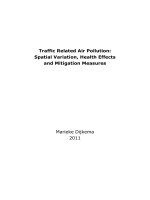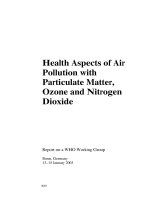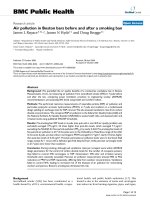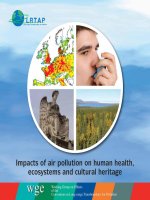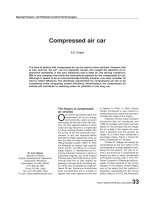Air Pollution Control Systems for Boiler and Incinerators.Unique control problems_3 pot
Bạn đang xem bản rút gọn của tài liệu. Xem và tải ngay bản đầy đủ của tài liệu tại đây (251.74 KB, 13 trang )
TM 5-815-1/AFR 19-6
5-1
CHAPTER 5
MEASURING TECHNIQUES
5-1. Criteria standards. For the determination of possible violations
In order to evaluate the nature and magnitude of air
pollution, establish remedial measures, and determine
control programs, it is necessary to test for the exist-
ence of pollutants. In the upgrading of existing installa-
tions, compliance is determined through "point source
emission rate tests." Revisions to the regulations
regarding air pollution test requirements for federal
installations appear in the Federal Register.
5-2. Stack and source measurement tech-
niques
The point source emission rate test methods and
requirements are covered under Environmental Pro-
tection Agency Regulations on Standards of Perform-
ance for New Stationary Sources, 40 CFR 60 and
subsequent revisions. The techniques are listed in table
5-1.
5.3 Meteorological and ambient air mea-
surement
a. Measurements. Air quality measurements are
used to trace emission sources and determine if these
sources comply with federal, state, and local air quality
of air quality, the continuous monitoring of pollutant
concentrations is normally required for a one-year
period. Air quality measurements are a function of the
sampling site, the local meteorology, the methods used,
and the existing pollutant concentration in the
atmosphere. Personnel knowledgeable and experienced
in meteorology and air quality testing are needed to
conduct and evaluate air-quality measurements.
b. Sampling technique. The criteria for instrumen-
tation, calibration, and use of EPA-approved sampling
techniques are covered under 40 CFR 53
Environmental Protection Agency Regulations on
Ambient Air Monitoring Reference and Equivalent
Methods. See table 5-2.
(1) Continuous sampling is the recommended
technique for obtaining the most reliable
information concerning the variation of
pollutant concentration in the real
atmosphere. Discrete sampling can be used
for plume tracking and random checking.
Discrete sampling should be used with
caution, however, when measuring any of
several pollutants that have daily variations.
(For example, ozone has very low con-
centrations at night.) In addition, use of
discrete sampling methods will often result
Simpo PDF Merge and Split Unregistered Version -
TM 5-815-1/AFR 19-6
5-1
CHAPTER 5
MEASURING TECHNIQUES
5-1. Criteria standards. For the determination of possible violations
In order to evaluate the nature and magnitude of air
pollution, establish remedial measures, and determine
control programs, it is necessary to test for the exist-
ence of pollutants. In the upgrading of existing installa-
tions, compliance is determined through "point source
emission rate tests." Revisions to the regulations
regarding air pollution test requirements for federal
installations appear in the Federal Register.
5-2. Stack and source measurement tech-
niques
The point source emission rate test methods and
requirements are covered under Environmental Pro-
tection Agency Regulations on Standards of Perform-
ance for New Stationary Sources, 40 CFR 60 and
subsequent revisions. The techniques are listed in table
5-1.
5-3. Meteorological and ambient air mea-
surement
a. Measurements. Air quality measurements are
used to trace emission sources and determine if these
sources comply with federal, state, and local air quality
of air quality, the continuous monitoring of pollutant
concentrations is normally required for a one-year
period. Air quality measurements are a function of the
sampling site, the local meteorology, the methods used,
and the existing pollutant concentration in the
atmosphere. Personnel knowledgeable and experienced
in meteorology and air quality testing are needed to
conduct and evaluate air-quality measurements.
b. Sampling technique. The criteria for instrumen-
tation, calibration, and use of EPA-approved sampling
techniques are covered under 40 CFR 53
Environmental Protection Agency Regulations on
Ambient Air Monitoring Reference and Equivalent
Methods. See table 5-2.
(1) Continuous sampling is the recommended
technique for obtaining the most reliable
information concerning the variation of
pollutant concentration in the real
atmosphere. Discrete sampling can be used
for plume tracking and random checking.
Discrete sampling should be used with
caution, however, when measuring any of
several pollutants that have daily variations.
(For example, ozone has very low con-
centrations at night.) In addition, use of
discrete sampling methods will often result
Simpo PDF Merge and Split Unregistered Version -
TM 5-815-1/AFR 19-6
5-2
in economically unacceptable manpower
requirements. In these cases, sampling with
continuous instruments and recording on
data charts provides a lower cost solution.
(2) Air quality regulations require the measure-
ment of extremely small pollutant con-
centrations (1/100 of a part per million by
volume). Sensitive instruments capable of
detecting small concentrations are needed.
c. Sampling method for carbon monoxide. The fed-
eral reference method for measuring carbon monoxide
is the instrumental nondispersive infrared technique. A
typical instrument consists of a reference cell filled
with CO free air, and a sample, or detector, cell. The
difference in transmittance of infrared radiation passing
through the sample cell and the reference cell is sensed
by a photon detector. The difference is a measure of
the optical absorption of the CO in the sample cell and
is proportional to the CO concentration in the sample.
The signal from the detector is amplified and used to
drive an output meter as a direct measure of CO
concentration. This method is precise and accurate.
d. Sampling method for sulfur dioxide. The West-
Gaeke sulfuric acid method is the Federal reference
method for measuring sulfur oxides. The West-Gaeke
method is a discrete bubbler technique which involves
bubbling ambient air through an impinger for 24 hours.
Sulfuric acid is added to the absorber to eliminate
interferences from oxides of nitrogen. SO is collected
2
in a tetrachloromercurate solution. When acid bleach
pararosaniline is added to the collected SO together
2
with formaldehyde, a red-violet compound is formed
which is then measured spectrophotometrically. This
method is a discrete instrumental sampling method, but
may be modified for continuous use.
e. Sampling method for oxidants and ozone. The
instrumental-chemiluminescence method is the federal
reference method for measuring ozone. Upon mixing
ambient air and ethylene in the testing instrument,
ozone reacts with the ethylene to emit light. This light
is measured by a photomutiplier. If the air and ethylene
flow rates are constant, and the proportion of air and
ethylene therefore known, the resulting signal can be
related to ozone concentration. Analyzers are cali-
brated with a known ozone concentration.
f. Sampling method for nitrogen dioxide. The fed-
eral reference method for NO is the indirect measure-
2
ment of the concentration of nitrogen dioxide by
photometrically measuring the light intensity of wave-
lengths greater than 600 nanometers resulting from the
gas phase chemiluminescent reaction of nitric oxide
(NO) with ozone (O ).
3
g. Sampling method for total hydrocarbons. Gas
chromatography flame ionization is the federal refer-
ence method of measuring total hydrocarbons.
h. Sampling method for particulates.
(1) Total suspended particulates. The high
volume air sample is the federal reference
method for measuring total suspended
particulates. Air is drawn (at 40 to 60
ft /min) through a glass fiber filter by means
3
of a blower, and suspended particles having
an aerodynamic diameter between 100 and
1.0 micron are collected. The suspended
particulate is calculated by dividing the net
weight of the particulate by the total air
volume samples and is reported in ug/m .
3
(2) Coefficient of haze (C OH). A few states
have standards for a particulate measurement
called the coefficient of haze. This measure-
ment is reported in units of COH/1000 linear
feet of sampled air. In this method, air is
drawn through a small spot on a circle of
filter paper until the equivalent of a 1000 feet
long column of air of the diameter of the spot
has passed through the filter paper.
Transmittance through this spot then serves
as a measurement of particulate material
collected on the filter. There are considerable
doubts as to the usefulness and true meaning
of COH data, since the transmittance
recorded is a function of the nature of the
particulate as well as the total weight
sampled.
(3) Dustfall (settleable particulates). Several
states have standards for the amount of par-
ticulate that settles out of the air over a given
length of time (one common unit is grams/
square meter/30 days). The method of
collection is generally the dust bucket. A dust
bucket is a 15-inch deep metal or plate con-
tainer with a 6-inch opening that is exposed
to the air generally for a period of one month.
Dust buckets should be partially filled with
distilled water (or antifreeze) which prevents
the transporting of dust out of the buckets by
strong winds. This water also acts as a wash
at analysis time. After evaporating the water,
the remaining material is weighed and the
residues are converted to the required units.
i. Traceable compounds. Test methods for com-
pounds other than those for which standards exist are
often useful in evaluating stack dispersion. If unusual
fuel additives are used, or if incinerators are used to
dispose of specialized materials, laboratory chemists
can often devise sampling methods to measure these
compounds in the atmosphere.
j. Ringelmann standards. Particulate matter such as
soot, fly ash, and droplets of unburned combustibles
present in exhaust gases tend to impart blackness or
opacity to a plume. It is assumed that the darker the
shade of gray or black, the greater the concentration of
particulate matter present in a plume. The Ringelmann
Simpo PDF Merge and Split Unregistered Version -
TM 5-815-1/AFR 19-6
5-3
Chart offers a set of standards with which to measure have a removable cover. On double wall stacks
the opacity of an effluent plume. By the comparison of sampling ports may consist of a 4-inch diameter pipe
the blackness of a plume to the blackness of a series of extending from 4 inches outside the stack to the inner
graduated light diffusers, a Ringelmann number corre- edge of the inner stack wall. Accessible sampling ports
sponding to a percent opacity can be assigned to the shall be provided and located so that the cross sectional
plume (see table 5-3). It should be noted that while area of the stack or flue can be traversed to sample the
Ringelmann numbers give a relative indication of flue gas in accordance with the applicable current
plume opacity, they bear no direct relationship to federal or state regulations for fuel burning equipment.
plume particulate loading. They should supplement but
not replace point-source emission tests. 5-5. Air pollution project contacts
5-4. Flue gas sampling ports
Sampling ports are approximately 4 inches in diameter, ment for compliance with regulatory standards.
extend out approximately 4 inches from the stack, and
U.S. Army Environmental Hygiene Agency (AEHA),
Aberdeen Proving Grounds, MD, may be contacted for
the respective service air pollution projects on the fol-
lowing:
a. Source testing to characterize pollutants for
design controls.
b. Consultation on test performance standards and
witnessing tests.
c. Testing of installed air pollution abatement equip-
Simpo PDF Merge and Split Unregistered Version -
TM 5-815-1/AFR 19-6
6-1
CHAPTER 6
CYCLONES AND MULTICYCLONES
6-1. Cyclone be handled and high collection efficiencies are needed
The cyclone is a widely used type of particulate collec-
tion device in which dust-laden gas enters tangentially
into a cylindrical or conical chamber and leaves
through a central opening. The resulting vortex motion
or spiraling gas flow pattern creates a strong
centrifugal force field in which dust particles, by virtue
of their inertia, separate from the carrier gas stream.
They then migrate along the cyclone walls by gas flow
and gravity and fall into a storage receiver. In a boiler
or incinerator installation this particulate is composed
of fly-ash and unburned combustibles such as wood
char. Two widely used cyclones are illustrated in figure
6-1.
6-2. Cyclone types
a. Cyclones are generally classified according to
their gas inlet design and dust discharge design, their
gas handling capacity and collection efficiency, and
their arrangement. Figure 6-2 illustrates the various
types of gas flow and dust discharge configurations
employed in cyclone units. Cyclone classification is
illustrated in table 6-1.
b. Conventional cyclone. The most commonly used
cyclone is the medium efficiency, high gas throughput
(conventional) cyclone. Typical dimensions are illus-
trated in figure 6-3. Cyclones of this type are used
primarily to collect coarse particles when collection
efficiency and space requirements are not a major con-
sideration. Collection efficiency for conventional
cyclones on 10 micron particles is generally 50 to 80
percent.
c. High efficiency cyclone. When high collection
efficiency (80-95 percent) is a primary consideration in
cyclone selection, the high efficiency single cyclone is
commonly used (See figure 6-4). A unit of this type is
usually smaller in diameter than the conventional
cyclone, providing a greater separating force for the
same inlet velocity and a shorter distance for the parti-
cle to migrate before reaching the cyclone walls. These
units may be used singly or arranged in parallel or
series as shown in figure 6-5. When arranged in paral-
lel they have the advantage of handling larger gas vol-
umes at increased efficiency for the same power con-
sumption of a conventional unit. In parallel they also
have the ability to reduce headroom space require-
ments below that of a single cyclone handling the same
gas volumes by varying the number of units in opera-
tion.
d. Multicyclones. When very large gas volumes must
a multiple of small diameter cyclones are usually
nested together to form a multicyclone. A unit of this
type consists of a large number of elements joined
together with a common inlet plenum, a common
outlet plenum, and a common dust hopper. The
multicyclone elements are usually characterized by
having a small diameter and having axial type inlet
vanes. Their performance may be hampered by poor
gas distribution to each element, fouling of the small
diameter dust outlet, and air leakage or back flow from
the dust bin into the cyclones. These problems are
offset by the advantage of the multicyclone’s increased
collection efficiency over the single high efficiency
cyclone unit. Problems can be reduced with proper
plenum and dust discharge design. A typical fractional
efficiency curve for multi-cyclones is illustrated in
figure 6-6.
e. Wet or irrigated cyclone. Cyclones may be oper-
ated wet in order to improve efficiency and prevent
wall buildup or fouling (See fig. 6-7). Efficiency is
higher for this type of operation because dust particles,
once separated, are trapped in a liquid film on the
cyclone walls and are not easily re-entrained. Water is
usually sprayed at the rate of 5 to 15 gallons per 1,000
cubic feet (ft ) of gas. Wet operation has the additional
3
advantages of reducing cyclone erosion and allowing
the hopper to be placed remote from the cyclones. If
acids or corrosive gases are handled, wet operation
may result in increased corrosion. In this case, a
corrosion resistant lining may be needed. Re-
entrainment caused by high values of tangential wall
velocity or accumulation of liquid at the dust outlet can
occur in wet operation. However, this problem can be
eliminated by proper cyclone operation. Wet operation
is not currently a common procedure for boilers and
incinerators.
6-3. Cyclone collection efficiency
a. Separation ability. The ability of a cyclone to
separate and collect particles is dependent upon the
particular cyclone design, the properties of the gas and
the dust particles, the amount of dust contained in the
gas, and the size distribution of the particles. Most
efficiency determinations are made in tests on a geo-
metrically similar prototype of a specific cyclone
design in which all of the above variables are
accurately known. When a particular design is chosen
it is usually accurate to estimate cyclone collection
efficiency based upon the cyclone manufacturer’s
Simpo PDF Merge and Split Unregistered Version -
TM 5-815-1/AFR 19-6
6-2
efficiency curves for handling a similar dust and gas. efficiency curve in order to determine overall cyclone
All other methods of determining cyclone efficiency collection efficiency.
are estimates and should be treated as such. (1) A particle size distribution curve shows the
b. Predicting cyclone collection efficiency. A parti- weight of the particles for a given size range
cle size distribution curve for the gas entering a cyclone in a dust sample as a percent of the total
is used in conjunction with a cyclone fractional weight of the sample. Particle size
Simpo PDF Merge and Split Unregistered Version -
TM 5-815-1/AFR 19-6
6-3
Simpo PDF Merge and Split Unregistered Version -
TM 5-815-1/AFR 19-6
6-4
Simpo PDF Merge and Split Unregistered Version -
TM 5-815-1/AFR 19-6
6-5
distributions are determined by gas sampling inlet ductwork and the outlet ductwork. This pressure
and generally conform to statistical drop is a result of entrance and exit losses, frictional
distributions. See figure 6-8. losses and loss of rotational kinetic energy in the
(2) A fractional cyclone efficiency curve is used exiting gas stream. Cyclone pressure drop will increase
to estimate what weight percentage of the as the square of the inlet velocity.
particles in a certain size range will be b. Cyclone energy requirements. Energy require-
collected at a specific inlet gas flow rate and ments in the form of fan horsepower are directly pro-
cyclone pressure drop. A fractional efficiency portional to the volume of gas handled and the cyclone
curve is best determined by actual cyclone resistance to gas flow. Fan energy requirements are
testing and may be obtained from the cyclone estimated at one quarter horsepower per 1000 cubic
manufacturer. A typical manufacturer’s frac- feet per minute (cfm) of actual gas volume per one
tion efficiency curve is shown on figure 6-9. inch, water gauge, pressure drop. Since cyclone
(3) Cyclone collection efficiency is determined by pressure drop is a function of gas inlet and outlet areas,
multiplying the percentage weight of particles cyclone energy requirements (for the same gas volume
in each size range (size distribution curve) by and design collection efficiency) can be minimized by
the collection efficiency corresponding to that reducing the size of the cyclone while maintaining the
size range (fractional efficiency curve), and same dimension ratios. This means adding more units
adding all weight collected as a percentage of in parallel to handle the required gas volume. The
the total weight of dust entering the cyclone. effect on theoretical cyclone efficiency of using more
6-4. Cyclone pressure drop and energy pressure drop is shown in figure 6-10. The increased
requirements collection efficiency gained by compounding cyclones
a. Pressure drop. Through any given cyclone there
will be a loss in static pressure of the gas between the
units in parallel for a given gas volume and system
in parallel can be lost if gas recirculation among
individual units is allowed to occur.
Simpo PDF Merge and Split Unregistered Version -
TM 5-815-1/AFR 19-6
6-6
6-5. Application other equipment or as a final cleaner to improve
a. Particulate collection. Cyclones are used as par-
ticulate collection devices when the particulate dust is
coarse, when dust concentrations are greater than 3
grains per cubic foot (gr/ft ), and when collection effi-
3
ciency is not a critical requirement. Because collection
efficiencies are low compared to other collection
equipment, cyclones are often used as pre-cleaners for
overall efficiency.
b. Pre-cleaner. Cyclones are primarily used as pre-
cleaners in solid fuel combustion systems such as
stoker fired coal burning boilers where large coarse
particles may be generated. The most common applica-
tion is to install a cyclone ahead of an electrostatic
precipitator. An installation of this type is particularly
Simpo PDF Merge and Split Unregistered Version -
TM 5-815-1/AFR 19-6
6-7
Simpo PDF Merge and Split Unregistered Version -
TM 5-815-1/AFR 19-6
6-8
Simpo PDF Merge and Split Unregistered Version -
TM 5-815-1/AFR 19-6
6-9
Simpo PDF Merge and Split Unregistered Version -


